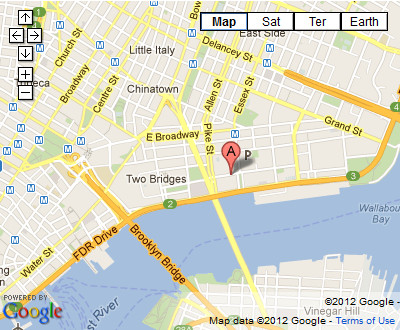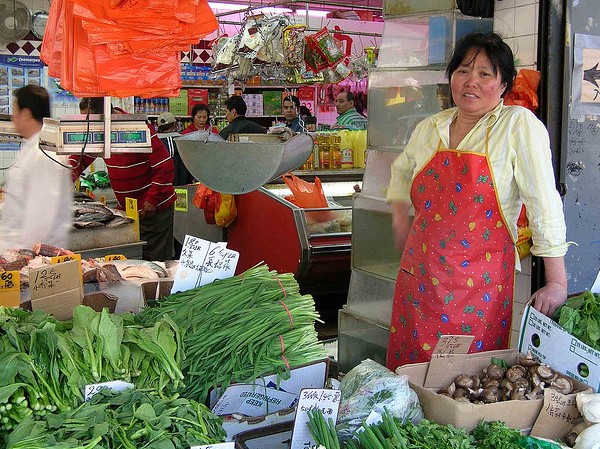If the grocery store is going to be saved, it will need to happen now.

October 26, 2012
 Usually, I go to Pathmark after my run. But ever since the news of this supermarket’s imminent closing, I’ve been avoiding it, and I think I know why. As someone with serious separation anxiety, even when it comes to supermarkets, I’m trying to prepare myself emotionally by pretending it’s already gone.
Usually, I go to Pathmark after my run. But ever since the news of this supermarket’s imminent closing, I’ve been avoiding it, and I think I know why. As someone with serious separation anxiety, even when it comes to supermarkets, I’m trying to prepare myself emotionally by pretending it’s already gone.
This Thursday afternoon, though, I really can’t help myself. While jogging in Manhattan Chinatown, I veer away from the East River, run up Pike, and find myself walking across the vast parking lot of 227 Cherry Street. I grab a shopping cart and push my way into the store.
Inside, a semblance of normality still prevails among the crowds of families, the children who insist on steering carts stacked high with family-sized versions of everything, and the elderly who stroll with hands behind their backs, shopping for nothing in particular. There are also firefighters eating sandwiches and ambrosia parfaits. I, for one, have always appreciated these opportunities to gawk at their ample musculature.
 The frozen food aisle is fully stocked, its items not yet priced for clearance. This is reassuring. I find myself loading up my cart with fish sticks.
The frozen food aisle is fully stocked, its items not yet priced for clearance. This is reassuring. I find myself loading up my cart with fish sticks.
The checkout lines are as long as ever—we wind ourselves elaborately into one another, snaking around displays of Halloween candy. Before, the long lines would have made me bristle with annoyance, but now I can only think about how all of these customers are going to be cut off in a couple months. All the families and retirees, all the firefighters. A lot of these customers live in the NYCHA buildings nearby. Some of these customers, particularly the seniors, come here every day, sometimes twice a day.
Ahead of me in the line is a Chinese grandmother who wants to reclaim some coupons, but the checkout girl tells her that since the store is closing in December, the coupons are no longer valid. This news sends a shudder down the line. It’s like a game of telephone.
“What? The store is closing?”
“Can’t reclaim the coupons. She says the store is closing in December.”
“And closes at 1 a.m., starting soon. Not 24 hours anymore.”
“The store and pharmacy will close at 1? Oh my god.”
The thing with a 24-hour market is that it’s always there, whether you’re coming home drunk or waking up at five in the morning. I love the predawn pace in these dim hours, when employees stock while freestyling to the radio.
“God, this is so depressing,” the woman in front of me says. Her daughter looks up at all the whispering adults.
“What’s happening?”
“Pathmark is closing,” the mother says.
“What? Why?”
“Someone bought the property or something.”
“What’s property?” the daughter asks.
“And they’re going to build condos?” The mother clarifies this point with the checkout girl. “You’ve got to be kidding me.”
December. Holiday season. By Christmas, these shelves will be empty.
—
I realize that not everyone can afford to say goodbye to Pathmark with such ineffectual passivity. For a neighborhood resident like me, the closing represents, at worst, an inconvenience. I can still buy fruits and vegetables from the many Asian-run markets in Chinatown. I can still go to Whole Foods in a pinch. I can even afford to buy single rolls of toilet paper from the downstairs bodega.
But for many in this community, this supermarket is a vital necessity. There are simply no other markets in this area. It seems ethically unpardonable to leave so many thousands of families in this predicament.
On October 10, the Two Bridges Neighborhood Council organized a rally to protest the store’s closing. It had rained that morning, and a dull mist clung to the air. The sun shone weakly behind grey clouds. Despite the weather, a restless crowd had gathered in the lot, near the Pathmark pharmacy. Many came to the rally bearing signs. Many were in wheelchairs. Many were elderly. “Save Our Pathmark!” they shouted.
Public officials spoke at the makeshift podium.
 “For thousands of people in this neighborhood, Pathmark is literally the only option,” said Sheldon Silver, the New York State Assembly speaker. “We will not stand by and allow our seniors and our families to lose their local and affordable supermarket.”
“For thousands of people in this neighborhood, Pathmark is literally the only option,” said Sheldon Silver, the New York State Assembly speaker. “We will not stand by and allow our seniors and our families to lose their local and affordable supermarket.”
“If the developer comes into our community, they have to know what our needs are,” said Councilmember Margaret Chin. “We are not going to allow this place to turn into something that we cannot afford.”
Frank Modica shared a story about a 98-year-old woman who goes to Pathmark and the pharmacy twice a day. Esther Wang of nonprofit organization CAAAV translated a statement from Mr. Fuko Poon, who said that he also goes to Pathmark twice a day.
Representatives from GOLES, a neighborhood housing and preservation organization, and the New York City Housing Authority, expressed dismay that something as basic as affordable food would be taken away from the residents. “As we lose other things, we can’t stand back and let them [take affordable food] away from us.”
“They say it’s a done deal, but it’s not,” added Margaret Chin.
Maybe so. In 2007, amid financial problems, Pathmark threatened to close, but community residents and leaders were able to fight against the measure.
But the pharmacy already closed this week. And “50 percent off” signs have gone up on Pathmark’s windows. If Pathmark is going to be saved, it will need to happen now.
—
After the rally, I stuck around and talked to Ms. Chun, 70, who lives in one of the NYCHA buildings in the area. She said that everyone in her building was discussing Pathmark’s closing. Many of the seniors in the building can’t walk—a lot of them are wheelchair bound, so they had sent her as an envoy. She would have to bring them the news.
I asked Ms. Chun, who was from Shanghai, if it would be possible for her to purchase her groceries from the Asian-owned markets instead.
At this, she flapped her hand vigorously as if to say “Come here, look.” From her pocket, she pulled out a bright orange Post-it, on which her daughter had written in Chinese, “Pathmark is closing? Where will we buy cat litter?”
“See?” she said. “Someone told me I could buy cat litter up at 14th Street. Do you know how far it is? It’s too expensive to go all the way up there.”
Asian stores did not offer everything, she concluded. There were so many items that one needed besides cat litter.
I imagine every resident in the Two Bridges area has their own Post-it note filled with items they’ll no longer have access to—not just the essentials, but Thanksgiving dinners, birthday cakes, and the sense of dignity and comfort in knowing that you have somewhere to go.

A luxury condo complex, for example, is not a place where Ms. Chun or her friends can go. Even if another market opens after the condos are completed, it will undoubtedly be out of Ms. Chun’s price range.
But Ms. Chun was optimistic. She was here in 2007, after all, when the store threatened to close but didn’t.
“I feel heartened to see that all these people have come together to fight this closing. The public officials”—she gestured—“the residents, reporters like you…I believe in America. America is a democracy, a populist country. America cares about everyone, even poor people. I think we can do this. In 2007, they said they would close, but we were able to stop them from closing. We can do it again.
“The developers weren’t thinking of us. But we will make them think about us.”






